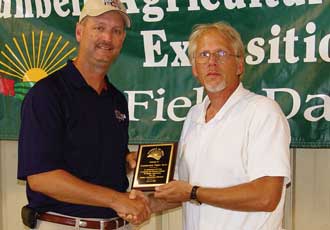August 31, 2010

Plant growth regulators, potassium deficiencies and thrips are all the focus of University of Georgia cotton research being conducted at the Sunbelt Ag Expo in Moultrie, Ga.
Extension specialists described the various trials during the annual Field Day on July 8.
UGA Extension cotton agronomist Guy Collins says one of the most common questions he has received this year is how to manage the growth of newer cotton varieties. “We’re in a state of transition as far as the varieties being planted across Georgia. A lot of them appear to be earlier maturing and fruit up more quickly than DPL 555. As a result, we’re trying to modify our plant growth regulator strategies. We can overdo an early application with some of these newer varieties. We don’t want to force the cotton into a premature cut-out and hinder our yield potential,” says Collins.
It’s important to realize that there is no one-size-fits-all approach to growth management, especially now that Georgia cotton producers are planting a wide array of varieties with variable growth potential and maturity, he says.
“Even within similar environments — irrigated or dryland — it’s difficult to generalize PGR recommendations for newer varieties, as substantial research efforts addressing this issue are currently under way. Therefore, each field should be treated on an individual basis, and we need to rely on past experience. In any case, it is important to monitor growth closely and frequently and to only treat fields that exhibit potential for excessive growth — not prophylactically, when plants are not growing vigorously, especially in dryland fields,” says Collins.
It’s critical, he says, that growers make their PGR decisions on a case-by-case basis, and to monitor growth frequently to determine the necessity of additional mid-bloom PGR applications. “Remember that environment tends to play a very strong role in the necessity of PGR applications. Just because you grow cotton in a dryland field does not mean that excessive growth can’t occur, and vice-versa for irrigated fields.
“The same idea applies to variety maturity. PGRs should only be applied on an as-needed basis, when there are signs of current and expected vigorous growth. PGRs should not be applied when there is insufficient soil moisture, especially in dryland fields,” he says.
Also at the Expo, UGA soils and fertilizer agronomist Glen Harris has been looking at potassium nutrition for cotton. “We’ve seen some problems and we think there are a number of reasons for those. One is that fertilizer prices peaked in 2008, and after that, nitrogen and phosphorus prices came down significantly. For potash, the prices stayed up,” he says.
In Georgia, says Harris, growers have seen significant rainfall dating back to last spring, and potassium can leach in sandy soils.
“Another issue is that these newer varieties are shorter-season, they fruit up faster, and they are more susceptible to a potassium deficiency. This is the second year of our test at the Expo, and we’ve got four different varieties, different maturities, and different potassium rates. We can always see symptoms showing up in the low-potassium plants. Early signs include the yellowing between the veins on the leaves,” he says.
If growers catch it early, says Harris, there are some things that can be done about it. “Our treatments include foliar potassium or feeding through the leaves. This can help you make up some ground if you catch the deficiency early. If you let it go to far it can become severe, and by the fourth week of bloom, it’s hard to rescue the plant and do anything for it,” he says.
On the plots where potassium was not applied last year, yields were about 300 pounds per acre, he says. On plots with the recommended rate of potassium, yields were 1,500 pounds per acre.
UGA Extension entomologist Phillip Roberts says the most predictable insect pest of Georgia cotton is thrips. “We don’t give a lot of thought to thrips because on most of our acres, we use something at planting, whether it is Temik or a seed treatment. But we do spray quite a bit of foliar insecticides for thrips,” he says.
In the second year of a study at Expo, researchers are attempting to better define when seedlings are most sensitive to yield loss from thrips, says Roberts.
“We do that with a lot of foliar applications, basically, and protect it during certain growth stages. One thing we’ve seen — and the data is almost identical to last year — is that the yield loss potential is greatest very early in that seedling development. If you have issues with thrips, some serious yield loss can be incurred at the one and two-leaf stage of cotton.
“Once we get up to four and five-leaf cotton, it’s rare that we see a yield loss, and we’ve conducted a lot of trials over the years. The point we want to make is that you lose yield potential to thrips very early in the development of that cotton seedling.”
Georgia growers spray a lot of cotton at the four and five-leaf stage, and Roberts says it doesn’t appear to help in terms of protecting yields. “We don’t want you to make any insecticide applications unless you absolutely need it to be profitable. More importantly, we don’t want to disrupt the system and increase the likelihood of having other pests. We’ve been concerned for a couple of years now about spider mites, and in Georgia we don’t treat any acre for spider mites. But we do see them more frequently, especially in southwest Georgia. We’re learning about mites and trying to better understand thrips because we want to avoid getting into a problem with spider mites. They are expensive and difficult to deal with.”
About the Author(s)
You May Also Like




